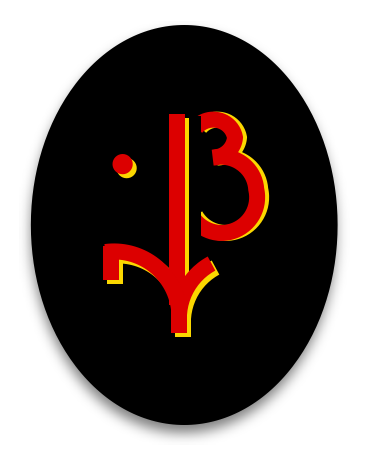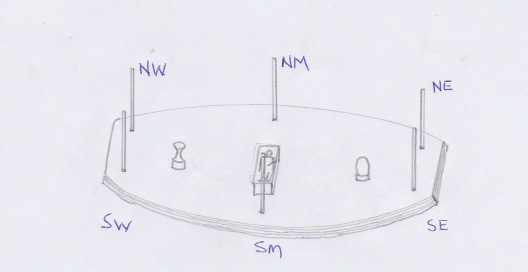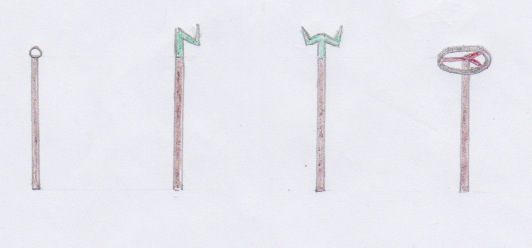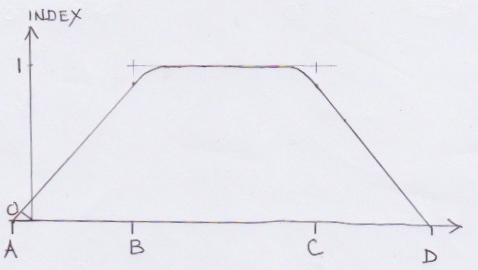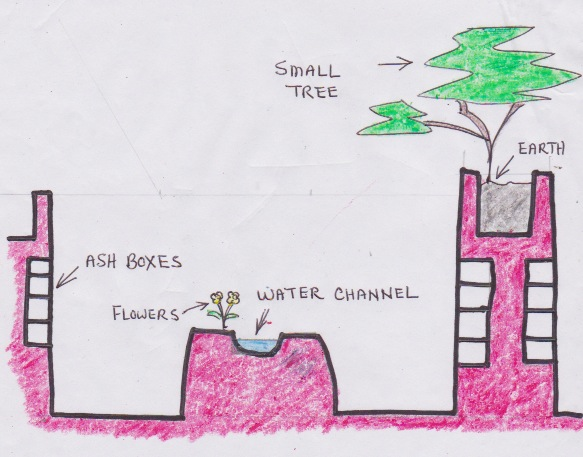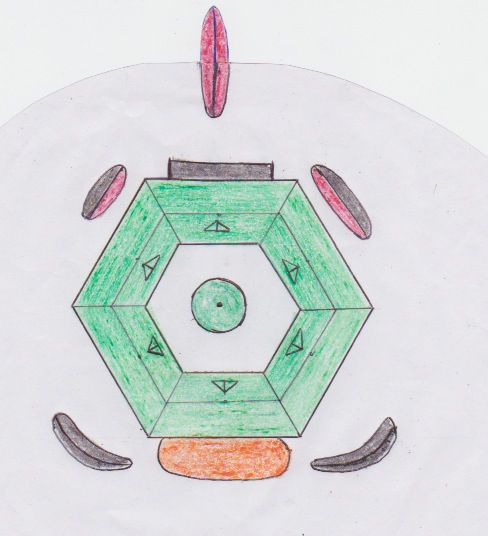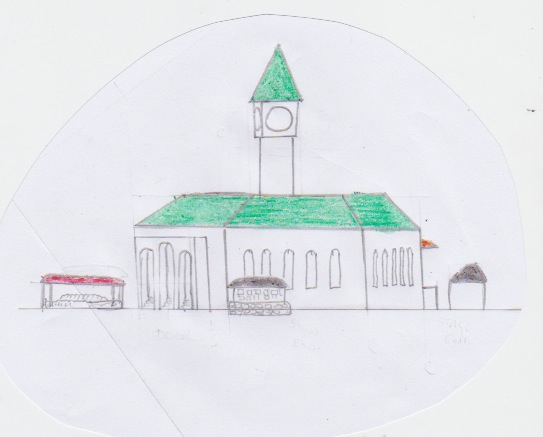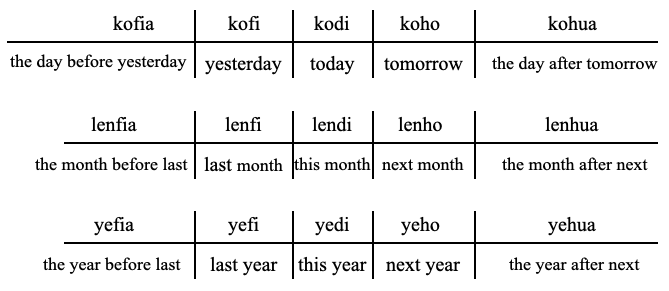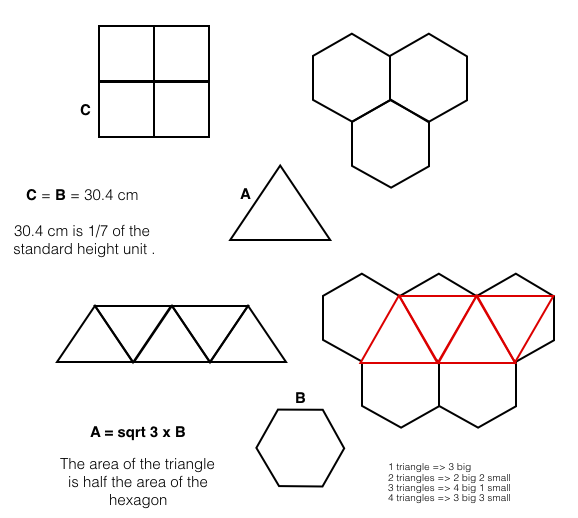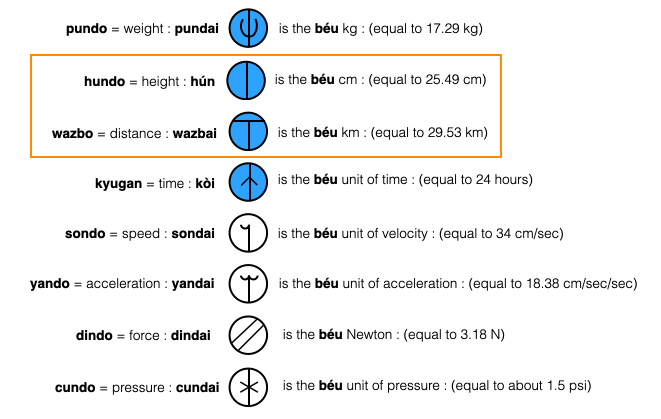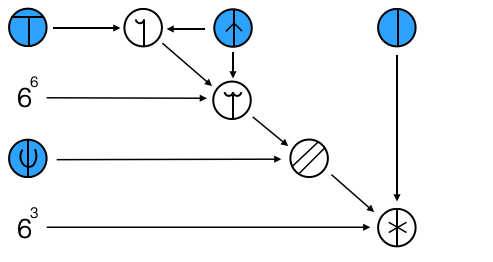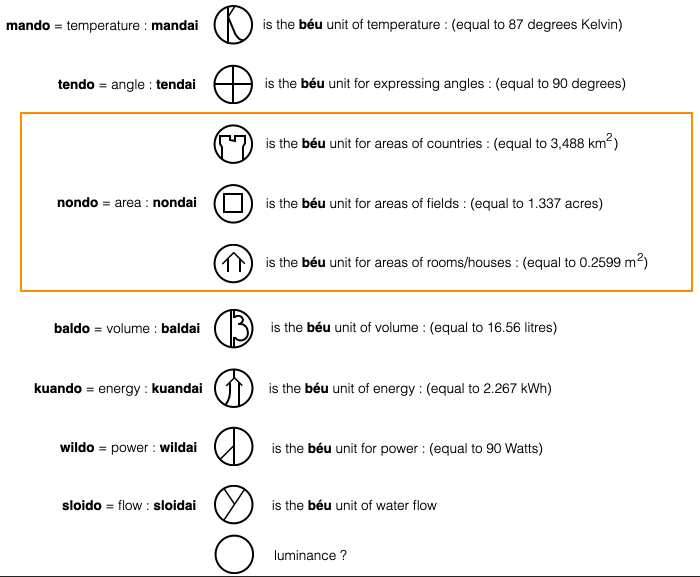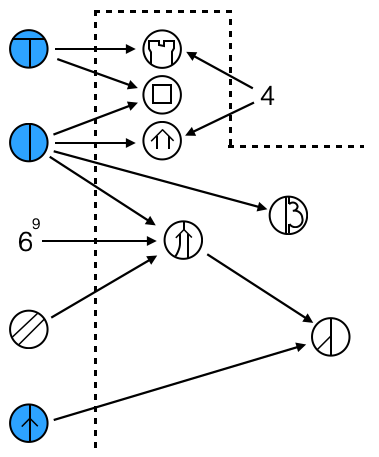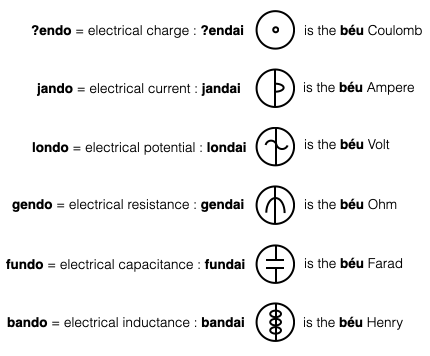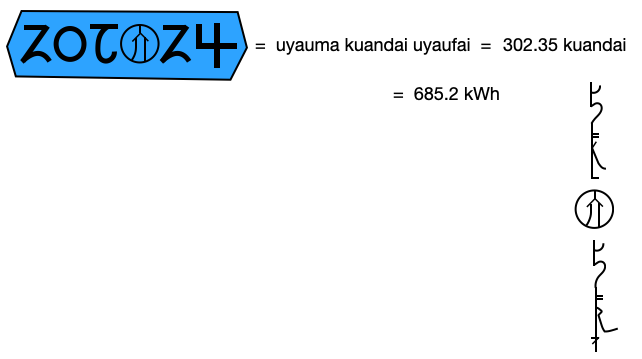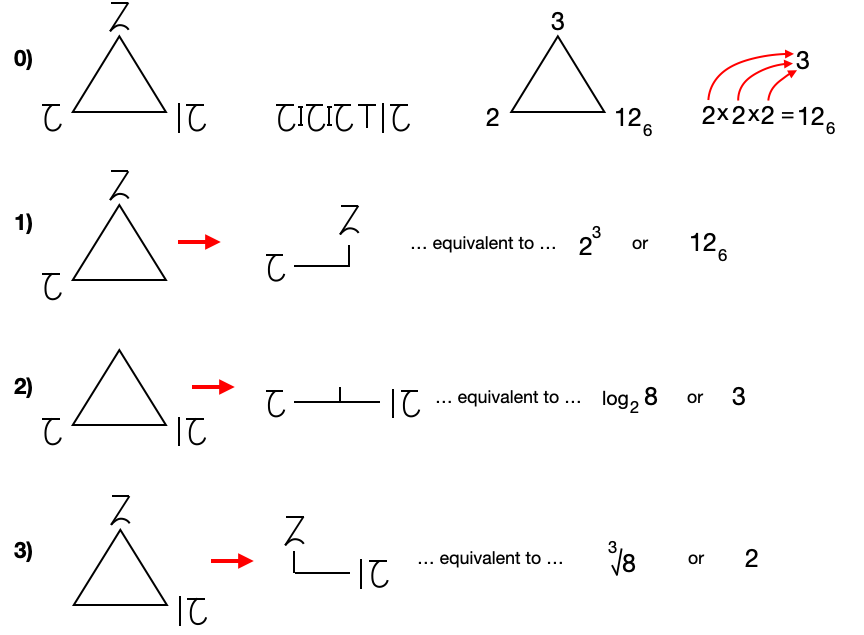Béu : Chapter 7 : Way of Life 1
Contents
- 1 ..... The cremation oval
- 2 ..... The sky garden
- 3 ..... Names of religions
- 4 ..... The waterfall chimes
- 5 ..... honda lé aska
- 6 ..... The twida
- 7 ..... The mandu
- 8 ..... Coming of age
- 9 ..... The parish hall
- 10 ... Relative time
- 11 ... Building Codes
- 12 ... Dimensions
- 13 ... Higher maths
- 14 ... Functions and trig functions
- 15 Index
..... The cremation oval
Actually called "sky gate/door" in béu.
Below is shown a typical cremation oval. Typically they are placed in a wilderness area, maybe near the parish boundary. The platform is about 1.5 m high with steps all around. It has the shape of an oval, usually with the two sharp curves cut off. In the two foci we have two objects.
On the east side we have the kilo. It is a structure about 1.7 m high (standing on a plinth about .2 m high), which is in the shape of the Gherkin in London. Metal bands can be seen on its surface. Multifaceted with each facet made of a pink glass. It has a silver ball on top, about 15 inch in diameter.
On the west side we have the ulgu. It is a structure about 1.7 m high (standing on a plinth about .2 m high), which is in the opposite shape from the Gherkin in London. Metal bands can be seen on its surface. Multifaceted with each facet made of a purple/mauve glass. It has a golden ball on top, about 15 inch in diameter (its top side is jet black).
Six poles (called jomo) can be seen on the oval. These must be changed to suit every cremation. After a cremation they are left as they are, until the next cremation.
I have named them NM (north middle), NW (north west), SW (south west), SM (south middle), SE (south east) and NE (north east).
These jomo can have 1 of 4 types of head (shown below). From L => R, I have named these the empty head, single head, double head and multiple head.
A jomo is about 5 m high. The second and third tops are about 1.3 m high. The diameter of the 4th top is 2.1 m although on occasions this must be increased.
The jomo are made of varnished wood and are square in cross-section, 25 cm at the bottom, narrowing to 21 cm at the top. The 2 middle tops (see below) can be constructed from anything. However they should look solid and all faces should glow in the dark (not necessarily at the edges). The single and double heads gradually tapper to a point. They are square in cross-section, all the way to the point.
Basically the choice of head reflects the descendants that the deceased left behind. If the deceased had no living descendants at the time of death, then all the jomo have empty heads. This is a greyish/white sphere.
If the deceased has living descendants then the NM jomo will have a single head. This head represents the oldest child (legally recognised child). If the first born was male, this head will be orientated out of the oval, if female into the oval.
The second oldest child is also represented by a single head. If this child was male, the next empty jomo in a clockwise direction from the NM one receives a single head. If this child was female, the next empty jomo in a anti-clockwise direction thom the NM one receives a single head.
And so you do with the third, fourth, fifth and sixth child . If there are only six children, then yellow bunting is drapped from the "elbow" of the head representing the six child. If this child was female, yellow bunting is drapped from the "elbow" of the head, if this child was male blue bunting is draped.
If there were seven children, then the last head placed should be a double head. Yellow or blue bunting being drapped from the "elbows" depending upon the sex of the last two children born.
If there were eight or more children born to the deceased, then the last head placed should be a multiple head. Yellow or blue bunting being drapped equip-distantly around the rim of the head to represent the sex of these children. In exceptional circumstances (when many, many children produced), the diameter of the multiple head has to be enlarged.
If any of these children have predeceased the deceased, then red bunting is draped from the "elbow" of the head representing them (if the elbow already has another colour of bunting, then the red bunting is intermixed with the yellow or blue bunting).
So now we have sorted out what heads we want and we have given the NM jomo head an orientation.
Now we give the other single heads an orientation (the double head is always orientated, so that you can see it best from where the deceased's head is). The multiple head has no orientation : it can spin.
The orientation of the other single heads depend upon the difference between the birthday of the first child and the child represented by that jomo. Here are two example to explain the system ...
1) The second oldest child is male. His birthday is exactly 4 months after the first born's. His head will be orientated 150 degrees anti-clockwise with respect to the first born's.
2) The tird oldest child is female. Her birthday is exactly 1 month after the first born's. Her head will be orientated 30 degrees clockwise with respect to the first born's. Note that male is anti-clockwise and female is clockwise.
Now we come to the tilting of the jomo. All jomo with a single head are tilted. The maximum tilt (that is the maximum deviation from the vertical is 30 degrees.
To work out the tilt for every jomo we first must work out the "Index" for the deceased. The index is some amount between 0 and 1. The index is got from the graph above. The horizontal axis is age and the high of the plotted line at the age in which the deceased died, determines his index.
The plotted line is can be plotted (by using a certain formula) when A, B, C and D are known. A is a constant (minus 9 months). B and C and D can be determined from the last 12 years of parish records. (By the way there are two graphs, one for each sex. And A and B and C are sex dependant.
Assuming the deceased is a male ...
B = the average age over the past 12 years in which the boys(young men) "mastered the laws".
C = the average age over the past 12 years in which the males married plus 18 years.
D = the average age of death for males over the past 12 years. No deaths that occur before "C", contribute to this average.
If the deceased is female, we determine our graph using the same formula, but now we have ...
B = the average age over the past 12 years in which the girls(young women) "mastered the laws".
C = the average age over the past 12 years in which the females married plus 30 years.
D = the average age of death for females over the past 12 years. No deaths that occur before "C", contribute to this average.
OK so now we have worked out the index for the deceased. Now each post with a single head is assigned a random number between 0 and 1.
The tilt of a post = Index x Random number x 30 degrees.
So this tilt is applied to the relevant post. The tilt follows the orientation of the head.
As can be imagined, every cremation involves a bit of work to have all the jomo at the correct orientation and tilt.
The followers of the béu-way believe that it is their duty to the ones they interact with, to assure that these "around-ones" are free from pain, free from want, and free from a spoilt/marrd heart. When one is asleep you are free from these things. Also in death ... hence béu-way followers do not believe that it should be a time of grief when somebody close to you dies.
..
..... The sky garden
After the body has been cremated, the ashes are put in a box and interred in the "sky garden". The sky garden takes the form of many wide "walkways" dug in the ground. From above it looks like a maze. The "ash boxes" are interred in either side of the walkways. There are four rows of these "ash boxes" deposited in each side.
A sky garden is ideally built on a gentle slope (in the Northern hemisphere, preferably south-facing to get the sun). It can be either built up from the ground or excavated into the earth.
The walkways are arranged in a sort of maze, so as to densely cover a piece of ground.
Although not absolutely necessary, most sky gardens have water running through them.
Below is a cut-away of a typical walkway. The bit in the centre (called "stream-work" in béu) has seats built into it. And also small flower beds. The inter-walkway walls support miniature trees or bushes. There is good drainage under the walkway. Mosses and small plants grow on the vertical surfaces. All in all, a sky garden is a very beautiful place, a place that should induce peace of mind to the people that wander its walkways or sit and ponder life.
The trick in designing a sky garden is too get the minimum slope needed to make this water flow. Ideally it should flow through all the walkways (not always possible). This is why a gentle slope is the best place to locate a sky garden.
The sky gardens are well looked after. They are an ideal place to visit if you want a bit of peace and quiet.
Over the hole in which the ash boxes are interred is placed a nice granite plaque with details of the life of the deceased. An image of the deceased at their prime is included. (With modern technology, people are now making in possible for visitors to see a multimedia presentation about the life of the deceased, this can be activated from a sensor in the plaque).
..
..... Names of religions
..
klisti = chistianity ... klistime = a christian (but not necessarily a churchgoer ... a believer) ... klistiki = a minister, a priest ... klistida = christendom (archaic term)
muzlu = islam ... muzlume = a muslim
buda = buddhism ... budame = a buddhist
yuda = judism ... yudame = a jew ... yudaki = a rabbi
sai.entolo = scientology ... sai.entolome = a scientologist
Note .... None of the above take the gan suffix in the manner béu does.
Note ... The ideas conveyed by béu and béugan overlap to a great extent. Maybe beugan is first used when first introducing the concept into a conversation, but after that just béu is considered sufficient. Also as a noun qualifier, béu is the form normally used.
Note ... béu can takes the place in a persons life normally taken by a religion, however following the way of béu does not bar one from following another religion. Just as being a Buddhist doesn't necessary force one to reject the Hindu gods.
Note ... béu is one of the few words that takes both the ki suffix and the me suffix.. Usually a noun would only be augmented with one of them. For example ...
pulis = the police ... puliski = a policeman (or policewoman) ... ʔazwo = milk ... ʔazwome = a milkman
It is thought that policemen co-ordinate their activities together and hence are given the -ki suffix.
It is thought that the milkmen don't o-ordinate their activities and hence are given the -me suffix.
Of course you might come across a situation where the police fail to co-ordinate their activities and a group of milkmen co-ordinate their activities brilliantly ... nevertheless ... puliski = policemn and ʔazwome = milkman.
Note ... beuda would be a contiguous area under béu political control ... similar to Christendom ... probably will never happen
..
..... The waterfall chimes
Near every habitation (well not individual houses) but every village anyway. Has a waterfall chimes. Nobody knows why they are called waterfall chimes. The chimes consist of three tubes that each produce a different note when hit. These chimes ring through out the day (especially late morning and mid afternoon) and give all hearers a feeling of supreme satisfaction. it gives them a feeling that all is well in the world.
beumi do not like noise around their habitations. They like to hear the sound that a breeze makes as it goes through the village. The biggest sound in a béu village is the sound of children playing. All vehicles are electric, all horses have rubber shoes and cart wheels have muffled rims. All machines of industry are carefully designed for quiet operation.
The bells ring out about every 15 minutes (but impossible to predict exactly). 29 (17 consonants + 11 vowels/diphthongs + R) symbols from the alphabet are encoded by the chimes. (27 three chimes long and 2 four chimes long ??) ... (the tone mark is not encoded, but it is not necessary for decipherment). Usually short poems, a bit like a Japanese haiku, are rang out. Nearly all adults can understand the chimes. They take great delight in hearing novel "haiku". Also people take great delight in composing novel "haiku" that relate a local happening concerning local characters. An appropriate "haiku" can be the talk of the village for months (and the talk of the neighbouring villages as well).
Also the chimes are used to inform people of things like football scores, etc. etc.
It is a bit of a mystery who actually operates the chimes. In fact children are told that "water spirits" are behind it all. Anyway even though the chimes seem to know all the successes/failures/embarrassments of the local population, nothing unkind is ever in the haiku. Many very funny things are in the haiku which indicates the content of the haiku approach a limit (but never should go across this limit ... well this is the theory anyway).
..... honda lé aska
..
In the Introduction I mentioned that honda lé aska are opposites ... like Yin and Yang.
In the Introduction I mentioned that honda lé aska are opposites ... like Yin and Yang.
However there is not any correspondence between the béu and the chinese concepts. Also the "sub-properties" associated with Yin and Yang have no correspondence with the "sub-properties" associated with the béu concepts.
Just for ease of reference I have listed the secondary concept associated with Yin and Yang below.
| YIN | YANG |
| femininity | masculinity |
| soft | hard |
| yielding | solid |
| passive | aggressive or active |
| fast | slow |
| the moon | the sun |
| black | white |
| cold | hot |
| wet | dry |
| water | fire |
| nighttime | daytime |
| the earth | the sky |
| diffuse | focused |
However "order" and "chaos" are associated with other concepts. They have each 2 "under-concepts" ...
honda is associated with the colour "sky blue" suna and "tranquility" sunan
aska is associated with the colour "orange" nela and "activity" nelas
And each under-concept is associated with one under-under-concept
And the under.concepts, have in turn, underconcepts of their own ...
sky blue nela => the sky nelda
orange suna => the sun kòi
tranquility sunan => dead soŋki
activity nelas => alive heŋgua
As well as no associations (for the most part) with the concepts linked to Yin and Yang ... also there is strictly no association with
good/bad, truth/falsehood, right/wrong, north/south, beauty/uglyness, positive/negative, right/left ... etc etc etc
..
Minor points pertaining to honda and aska
The "béu.symbol" is a orange disk with a sky blue background (the "béu.symbol" has both a simple and a complex representation)
This imagery continues into the way that machines are marked ...
To show that a machine is working, an orange disc is illuminated To show that a machine is switched off, a sky blue square is illuminated
The button to switch a machine on, is an orange disk with a black ring on it The button to switch a machine off, is a sky blue square with a black ring on it
(Of course the functions of indication and switching are often combined in one button)
For rocker switches (such as light swithes) the top part is square and you push this to switch off ... the bottom part is semicircular and you push this to switch on
By the way "red" is associated with danger and "green" is associated with safety So for example traffic lights are exactly the same (including the orange in the middle)
By the way there are no other associations with colour ... you do not talk about a blackheart or a yellow streak etc etc ... kids are not split up according to pink or blue clothes, etc etc
..
..... The twida
The nearest translation in English is "resolution" or "a standard of behaviour that is set by the individual themself. They can involve a variety of activities, but are often to do with diet and exercise.
People often adopt one of a recognised set of these twida, called a twidaibu. For example ... the twidaibu london is to do 100 push-ups + have heartbeat above 130 BPS for 20 minutes + walk 9 km every 24 hours.
People involved in twida involving fasting often wear a head band. Some who are less ostentatious go in for a plaque worn on one of their little fingers. But actually there is no requirements to wear either.
When you first become beumai they must undergo a ten day fast. This fast involves food only. There is no restriction of water. Also a few handfuls of rice grains are allowed every day ... just to counter stomach spasms. Now as you can imagine, his fast is extremely difficult to keep to. Most people doing it, wear a red headband when they are out and about. This help other people to avoid temping them with food among other things.
Many (maybe the majority) of beumai fast for two days out of 7. However this fast is only lasts from sunrise to sunset. Again there is no restriction on water and a little rice grains are allowed. If the beumai is above the latitude of 60 degrees (northern hemisphere) they are allowed to keep the fast times for somebody at 60 degrees. So you are limited to 19 hours of fasting in one day. It is usual to wear a white headband when out and about, doing this fast.
Another type of fast is to have a 4 day period every month involving a severely restricted food intake. It is usual to wear a light blue headband during that one.
Also some people who are cutting out salt have a grey patch on their headband.
Also some people who are cutting out sugar have a yellow patch on their headband.
..
However not all twida are to do with diet and exercise. Some example of other types of twida ...
a) Every second day to walk a certain path (say 500 mtr) and to pick up every piece of litter along that path.
b) To reach out to a stranger at every opportunity. Ideally to befriend one new stranger every month and to give advice/aid/(introductions to new people) to these new acquaintances.
c) Give a bath and slap up feed to a down-and-out every second week.
etc. etc. etc.
(SideNote) ... The three examples above should be are things that you can sign up for. That is ... there should be some co-ordination given from the kasʔau
(SideNote) ... In Japanese culture, hachimaki headbands symbolise determination or devotion. h)
..... The mandu
In ancient times an emperor could be made a state divinity (divus) by vote of the Senate. In modern times a person can be made a Saint by the Pope. Now mandu does not entail this sort of elevation. mandu are considered human with all the usual faults that humans have. But they are put on a pedestal to some extent. Maybe if the UK had an approved list if "military heroes" ... then all on the list would find their careers studied ... many would try emulate them ... it would give normal people something to aim for.
In the central garden and also around the elaʔa (south of the poster huts but north of the stage) are many statues representing the mandu. The mandu are deceased people who lead exemplary lives (at least one aspect of their life was exceptional). These people in no way achieve godhood or even sainthood ... but they are publicly held up as roll models for everybody. The statues are coloured as lifelike as possible. The mandu are also represented in the stain glass windows of the elaʔa. They are also represented in bass reliefs set against the elaʔa walls (both inside and outside). Inside the building they are represented by statues and tapestries and paintings. Around the outside areas containing these images are planted pleasant bushes and hedges : flower beds small lawns and walkways. Among these bushes and hedges are semi-secluded comfortable seats where people can sit and contemplate the images and also read the tomes that record the lives of these mandu. Inside also there are some indoor plants and soft seats for this purpose. Inside there is also an attendant whose task is to give out and take back these tomes.
"keeper of the tomes" and "keeper of the statues" are highly respected positions. (the job "keeper of the statues" is nearly all gardening)
There might be between 8 and 32 mandu celebrated at the particular kasʔau. The method of choosing these mandu is hazy.
There is a lot of variation among different kasʔau. They can also change over time as well.
Some examples (i.e. possible mandu) are .... Isaac Newton, Albert Einstein, Winstone Churchill, Nelson Mandela, Robert Plant, Bob Marley, Paolo Maldine, Terry McDermott, Horatio Nelson, Erwin Rommel, Nadezhda (Nadia) Vasil'yevna Popova, Thomas Edison, Steve Jobs, JRR Tolkien, Mervyn Peake, Jack London, Michael Moorcock, Jostein Gaarder, George Orwell, William Somerset Maugham, William Makepeace Thackery, Edgar Allan Poe .... etc. etc. etc.
About 50% of the mandu are very common and one would come across these many many times if you visited many kasʔau. However the remainder are less ubiquitous ... maybe a local war hero or writer or mathematician or whatever ... or often not local at all, but a second rank figure in some field that for some reason (???) was thought worthy of recognition. Some people travel from kasʔau to kasʔau and contemplate the lives of these lesser known* mandu (they usually set up their tents in the periphery of the mandu area : they are made welcome by the "keeper of the mandu)
- most adult are familiar with the life story of the better known mandu
..... Coming of age
In the ‘’’béu’’’ tradition there are two parts in life. Childhood and adulthood. XXXX is a noun referring to the change of state from childhood to adulthood. It also refers to the rites associated with this transition.
The responsibility to make sure a child behaves properly lies with its parents. Hence XXXX is seen as a relief to parents. They are being freed of a bunden. They no longer have to make sure their child follows the law of the land (maybe the law of the land says that they are responsible, but in the ‘’’béu’’’ tradition they are absolved of responsibility).
After this ceremony, you are no longer innocent and is responsible for his or her own actions. After this ceremony you are allowed to participate in all areas of community life and bear their own responsibility w.r.t. the law of the land, ‘’’béu’’’ rites and ethics.
Ceremony held 3 days before the full moon.
The ceremony is never held at home, but at the public hall. Every season 2 or 3 of these ceremonies are taken. The usual (short) speech about the responsibilities of adulthood. They will be shown around the rooms that are offlimit to kids (in the town hall) … brief lessons are given in every room. A travelling rug is given to the female XXXXME. This has been made by female relatives and many meaning full or traditional patterns are incorporated in the design. The boy is given a Swiss-army knife (equivalent). The ceremony finishes late afternoon. There is usually special food that night. Maybe siight-seeing early evening (if family have travelled from afar to witnes the ceremony)
Often the new adult is given some responsibility in the ‘’’béu’’’ community life. (Usually this will last about 6 months) … it is important to get the new adult involved and try and find a roll that they will enjoy. Of course some people are more suited to this sort of thing than others. No pressure is put on people to get involved in community affairs but an effort is put in to try and find a match between the offices that are open and what an individual would enjoy. It is good to make the XXXXME a “stakeholder” in the community as soon as possible.
For the male XXXXME, usually a journey unaccompanied by adults is undertaken … to visit an uncle … or equivalent male relative living a distance away … usually 2 weeks is spent away.
Sometimes two XXXXME that underwent the same ceremony will do the trip together.
For the female XXXXME sometimes a journey is undertaken, but in this case she is always accompanied by a responsible adult.
..... The parish hall
..
Below is shown the plan of the parish hall. This is the administrative centre of the parish and the place where the banner-rows point to.
The parish hall is referred to as tunheu. This refers to the hexagonal main building and the ancillary buildings and the adjoining grounds. If you want to refer to the main building alone you say wanwa (the hexagon). The red shape at the top of the plan is the water-fountain. It must have a red tiled roof. It is to provide clean drinking water to passers by and also a sheltered place to rest. It can take a variety of forms. Some are made very fancy and have a small "hanging garden" along their centre surrounded with pools filled with beautiful fish. There must be fresh water flowing, either continuous or on demand. Also there must be seating. There is also a small banner-row of 3 banners ... in line with the "water-hut" and on the side away from the wanwa.
There is often a tree lined avenue leading up to the front entrance of the tunheu. In hot countries the trees are usually some sort of shade tree. In colder countries, trees with a well defined, uniform shape are favoured ... poplars ?? The two rows of trees diverge from each other as the road passes the row of three banners. They open up to encompass the "poster-huts" but don't extend beyond them.
Usually 2 or 3 other types of tree are planted around the wanwa (maybe 5 or 6 trees in all). This makes every tunheu unique.
The whole complex provides the following services ...
1) A clock tower
2) Public toilets
3) A post office
4) A library
5) Archives for public records
6) A place for the parish council to meet
7) Offices for the parish council members
The black part of the wanwa is the main entrance.
You will notice to "huts" with half their roof red and half black. These are the "poster huts". These are sheltered billboards for posting important information. The red side is for official notices (that is for what the parish officers or the central government think should be posted). On the black side the general public can post whatever it wants. New notices are posted on the small "poster hut". After 9 days they are transferred to the larger "poster huts". In béu the adjective "red" can be used to refer to something pertaining to the government, and the adjective "black" to refer to something non-government.
The orange part of the wanwa is a stage, or actually the roof over the stage. And the area in front of this stage is a fairly large green where people gather to see the various shows that are put on. There are various consorts put on by the parish members at regular times every year. Also occasionally you get wondering groups of "players" who put on a show.
Above is how the tunheu looks from street level (the "hut" to the left is the "water hut").
The entrance has about 1.3 m of steps to climb. There are three arches at every entrance. The central one being slightly higher than the other two.
(I have probably drawn the building too high in the street level view). Usually tall stain glass windows on 4 sides of the wanwa. There is always at least 2 storeys within the main part of the building, sometimes more. Also usually there is a separate storey in the roof (the triangular shapes seen on the plan view, are actually windows in the roof to provide light to this storey. These windows look onto the central courtyard.)
The centre of the hexagon has a pleasing garden. In the very centre is the base of the "clock tower".
The 2 kidney shaped building are public toilets. The one on the right for the use of men, the one on the left for the use of women.
Tables and chair for setting out for the various concerts are also kept in these buildings. These toilets are kept meticulously clean. In fact every parishioner must do a certain amount of duty at the toilets every year ... keeping them clean. No fit adult is exempt from this duty.
There is a single banner just outside each of these buildings ... on the opposite side from the stage.
There are similar roof-coloring rules for other government buildings. Namely the schools have are gray-roofed and the hospitals are dark blue-roofed.
Just as every child (person that has not yet mastered the laws) has his "enjoyment day" (i.e. his birthday) so every parish has its enjoyment day. Every parish has a different enjoyment day and people frequently visit neighboring parishes to experience the neighboring parishes enjoyment day. In the enjoyment day there is a parade and people from different organisations and neighborhood enter "troops" into this parade. Everybody in a troop is flamboyantly and colorfully dressed. Also the pull bizarrely decorated wagons. Usually each troop picks a different theme every year so the dresses and the moves they perform reflect this theme. A prize is usually given to what is judged the best troop, but most people do not take that too seriously. They are just out to enjoy themselves.
At night there is tasty and abundant food available from tents that have been put up on the village green. The food is provided free of charge by the parish.
..
The government level of the wanwa provides a lot of services for its citizens. Such as waste bins, toilets, access routes, parks etc. etc. These are all designated amna (from Swahili "amma"). The opposite of amna is taitai "private" (derived from the reflexive pronoun tái)
..
... Relative time
..
béu has 15 special words that denote relative time.
..
..
kodi < kòi dí
lendi < lén dí
yedi < yé dí
..
The adjacent times are derived by mixing in the pila?o for "to" and "from".
The two extreme times are not really derived from anything ... useful words to have though.
..
... Building Codes
..
If tiling is used indoors, the tiles must be square.
If tiling is used in an outdoor area, the tiles must be hexagon.
If tiling is used in a roofed area lacking walls, the tiles should be laid in a square/octagon arrangement.
If drains must be accessed, triangular tiles must be used (relevant to outdoor area only). There must be an even number of these tiles at any access point. (I am talking about man-hole covers here)
..
..
... Dimensions
..
We have 24 units of measurement ... AKA "dimensions".
..
In CH4 ... "extended numbers" we saw that saukau was 1.016 x 10 14. This amount plus the mass of a neutron is used to define the béu unit of weight.
Mass of neutron ... 1.675 x 10 -27 kg
Multiplying by 1.016 x 10 14 gives 1.7018 x 10 -13 kg
Multiplying again by 1.016 x 10 14 gives 17.29 kg
This is called a pundai.
..
The unit of distance is derived from kaiwai (the reciprocal of saukau). This amount along with the length of an earth day plus the speed of light.
The distance light travels in one day ... 2.59 x 10 13 m
Multiplying by 9.8464 x 10 -15 gives 0.2549 m
This is called a hún.
..
..
In a similar manner to the SI derived units, béu uses a system of units that makes calculations and comparisons as easy as possible. There are 24 of these units. Each has its own sign.
The four signs that are coloured blue (they are not normally coloured blue) are the fundamental ones from which all the others are derived. The first one have a Universal provenance (mass of a neutron). The second one has both Universal provenance (speed of light) and the more down to earth "period of one earth rotation". The third one has the geocentric "radius of the earth times 6-3.
Of course the constant 115,84010 (wazbai/hún) is quite an important number. It is called nò tekan.
The unit of temperature is the mandai (87 degrees Kelvin)
This makes the temperature of the human body equal to 3 1/2 units. 3.0 manda is minus 12 degrees celsius and 4.0 manda is plus 75 degrees celsius. As the temperature of the air is nearly always between these two limits, when people discuss the weather, they invariably drop the initial "3".
..
[***tendo must change to son : tendai must change to sondai*** : sondo sondai => ???]
Note ... slòi is a verb meaning to flow : kuan is a noun meaning energy : wila is a noun meaning power.
..
I haven't as yet worked out appropriate values for the electrical units.
![]() ... sometimes the symbol for electrical potential (voltage) has a variant. The first symbol signifies alternating current while the second signifies direct current.
... sometimes the symbol for electrical potential (voltage) has a variant. The first symbol signifies alternating current while the second signifies direct current.
..
Now we discussed in CH4 how a noun phrase which contains a magnitude must be arranged. The number part of the NP is extracted and placed on the left, separated from the rest of the NP by the particle wì. For example ... ima balu wì moltai = 43210 doctors.
When we deal with one of the 24 "units words" the rules are different from normal nouns. For example, if pundai was a normal noun, my weight* would be written as ... *eja a?an ejauyai wì pundai However because pundai is special, we delete wì "of" and a?an "unit" and move pundai to where a?an was. Hence, my weight is ... eja pundai ejauyai
Another example ... if hún was a normal noun, my height would be written as ... *a?ai?a a?an imai wì hún. But as hún is a "unit word" my height is expressed as a?ai?a hún imai.
Below is an example of a unit sign and an associated amount. Written in "blue space" on the top and in "white space" on the right. Number symbols are strongly prohibited in "white space". But there is no such prohibition for "unit words".
But what if there was no a?an within the number string? Well in that case ...
1) If the number is greater than one, put the unit word to the right of the number string.
2) If the number is less than one, put the unit word to the left of the number string.
In the orthography (blue space) the numbers must be contiguous with a magnitude word. If there is a gap, then "zero" must be inserted into the gap. Actually the maximum number of zeros that will be ever needed is one ... when the number is one digit long and it ends in -ai.
..
* "Man is the measure of all things" ... Protagoras // For expressing the weight of a person, usually just two numbers are quoted. Usually an a number followed by a au/ai number. This is accurate to the nearest 240 grams, and a greater dynamic range than this is deemed unnecessary. For expressing the height of an adult, usually two numbers are quoted. Usually an ai/a number followed by a au/ai number. This is accurate to the nearest 2 mm, and a greater dynamic range than this is deemed unnecessary.
..
... Higher maths
..
We have encountered two mathematical operations that combine two numbers and produce a third ... namely addition and multiplation.
In this section I will introduce three more operations. However instead of being independent from each other like addition and multiplation these three operations are interdependent ... https://www.youtube.com/watch?v=sULa9Lc4pck .... interdependent in a cyclic way ... or a triangular way ...
By the way ... komo = "left", wimo = "zenith", bene = "right"
..
1) Would be pronounced komo ima _ wimo uya. Or if you want the answer, you would say komo ima _ wimo uya _ bene nén.
2) Would be pronounced komo ima _ bene a?aima. Or if you want the answer, you would say komo ima _ bene a?aima _ wimo nén
3) Would be pronounced wimo uya _ bene a?aima. Or if you want the answer, you would say wimo uya _ bene a?aima _ komo nén
It can be argued whether the three pairs komo ima / wimo uya / bene a?aima are in origin ...
a) A copula phrase with the copula dropped
b) Apposition
... I wouldn't worry about it though. Worrying about it serves absolutely no purpose.
..
It should be obvious, that this system is far far superior to the THREE different systems we have under the Western Mathematical Tradition (WMT).
..
Addendum ... Actually for the "to the power" operation, there is one more contraction that can occur. The important thing is that people can associate the contracted form back to the triangle form. The triangle form gives an intuitive hint as to the true relation between exponent/logs.roots.
Also the above is often pronounced ima _ wimo uya instead of the full komo ima _ wimo uya.
..
... Functions and trig functions
Here are some other symbols used for functions and variables ...
..
..
nogau = arithmetic
haijogu = haijogau = algebra ?
reciprocal = diapa ?
Note ... haigan is probably derived from the adjective hái. Likewise cogan from the adjective coga and gugan from the adjective guboi
..
If you wanted to express a number represented by digits 2->4 from the LHS of the monster, you would say aufaidaula nàin .... the same way as we have in the Western European tradition. However if you wanted to express a number represented digits 6 ->8 from the RHS of the monster, you would say yanfa elaimbau .... not the way we do it. This is like saying "milli 630 volts" instead of "630 microvolts".
laigau = calculus
yyyy = straight, straight line ... both an adjective and a noun
xxxx = curvy, a curve ............. both an adjective and a noun
Now xxxx also means function. Or at least instead of talking about putting x into a function (process) and obtaining y, the tradition in béu is to talk about xxxx defined in terms of x and y (either through an equation or simply a list of x and y values)
xxxx is usually written using the sign below.
xxxx is declared to exits in the dimensions (variabes) haigan and kyugan below.
xxxx is defined in terms of an equation below.
Now the differential of xxxx is called molgan xxxxwo and is written as .... (the image on the RHS is the second differential)
And the integral of xxxx is called fendagan xxxxwo and is written as .... (the image on the RHS is the second integral)
Note moloi = slant, slop, incline, gradient .... fenda = area
..
Index
- Introduction to Béu
- Béu : Chapter 1 : The Sounds
- Béu : Chapter 2 : The Noun
- Béu : Chapter 3 : The Verb
- Béu : Chapter 4 : Adjective
- Béu : Chapter 5 : Questions
- Béu : Chapter 6 : Derivations
- Béu : Chapter 7 : Way of Life 1
- Béu : Chapter 8 : Way of life 2
- Béu : Chapter 9 : Word Building
- Béu : Chapter 10 : Gerund Phrase
- Béu : Discarded Stuff
- A statistical explanation for the counter-factual/past-tense conflation in conditional sentences
